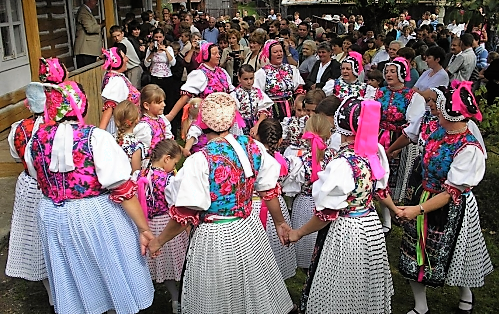Today I will continue with my series on Lemko / Rusyn folk costume. I will focus on the village of Jakubany. It seems that my overview is turning into a more in depth look. This village is south of Jarabina in the heights south of the Poprad valley, across a peninsula of Slovaks. It is north of the Torysky region which I spoke about in my last article.
Jakubany - Якубяны
This village has very well preserved folk traditions. They have a performing group named Kečera which maintains many of these. The image at the head of the article is this group demonstrating local wedding ceremonies. We see the bride seated at the left with her bridesmaids, the groom in the center with the wedding tree, and married women on the right. Here is a video of this group performing.
https://www.youtube.com/watch?v=xlgtF6kMpd0
The women's shirt is white linen with a band of red woven ornament on the cuff, as in Jarabina and the other villages in that group.
It is worn over a chemise which does not show when fully dressed, which extends at least to the knees to provide a foundation. The body and sleeves are full and gathered into the neckband. The sleeves most commonly seen are short.
However, long sleeved shirts also exist, for cooler weather, and more formal occasions.
This is sometimes replaced by a similar bodice made of sheepskin, which is ornamented differently.
The skirt was originally made of indigo batik print, as was common in much of this area, not only among the Lemkos / Rusyns, but also the Slovaks and even the Polish. Here they were usually had small ornaments printed on them. The skirt is usually pleated.
These were accompanied by white linen aprons or batik printed aprons with a frame on three sides and a larger motif.
For weddings and possibly some other ceremonies, the skirt was made of the same white linen with red woven stripe as the sleeves.
notice that the skirt is flat in front. This is almost always the case in folk skirts.
This skirt is accompanied with a white openwork apron.
Today skirts are usually made of commercial cloth, as you can see on the bride's mother above. They still prefer patterns of printed dots or other small motifs. They are often white, but may be made in other colors as well.
Take a look at this image. Here we can see the old batik printed apron on the right. On the left we see a newer version which is now more common, with colorful topstitching as an adjunct, or replacing the batik print. Sometimes this has woven white stripes on the outside three sides.
White aprons, often with openwork, are also worn
Colorful ribbons are attached to the apron ties, to bead chokers, and to the headdresses.
Unmarried girls wear their hair in a single braid.
Married women put their hair up on the back of the head, and cover it with a cap, chepets.
The colorful cap seems to be more popular among older women, and the black one with large openwork trim among the younger.
This may be covered with a kerchief when going out.
Putting the cap on the bride for the first time is an important part of the wedding ritual, as it is for most of the Slavic peoples.
For especially festive and ceremonial occasions unmarried girls wore a crown like headdress called parta. This is heavily beaded and has a panel of ribbons hanging down the back. This is often accompanied by a narrow shawl with wide crocheted borders.
A jacket of wool challis or brocade with long sleeves is worn by older women and in cooler weather.
A sheepskin jacket may be worn. They are usually accompanied by boots of heavy wool with leather trim. This is both for cold weather and formal occasions.
Besides these cloth boots, both moccasins and regular boots were worn in the past. Today one mostly sees black leather shoes.
The men wear a white linen shirt with red woven cuffs, similar to that of the women.
Heavy woven white wool pants and jacket, which are common to much of the Carpathian region, a hat, and a sheepskin vest complete the outfit. They likewise wore moccasins, but again today usually wear leather shoes.
Thank you for reading, I hope that you have found this to be interesting and informative.
Roman K
email:
For some of the images I am endebted to Jan Letowski. You may buy books and costumes from him here.
https://www.ebay.com/str/easterneuropeanart
Others I got from the village website, which you may visit here
http://www.jakubany.sk/
Here is another video of the local group performing, this time at a Rusyn Vatra in Cleveland. Good performance, even if the lighting is bad.
https://www.youtube.com/watch?v=9R6BtuSso7Y
Having fun in the neighboring village of Vislanka. Some of the people in the background are from different villages.
https://www.youtube.com/watch?v=FpimfSGLlfM











































































This is a well-written article. Thank you. I sponsored Kecera's tour in the US in 2014. They are fantastic.
ReplyDeleteMatching bridesmaid tees create picture-perfect moments for the wedding journey.
ReplyDelete